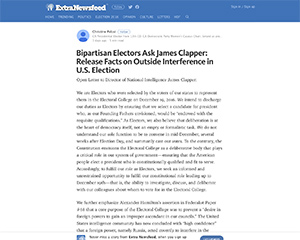- Election Day « Electoral College Machinations
 |
 |
 |
 |
 |
 |
 |
 |
DC Statehood Green Party South Carolina Democratic Party Michael Moore |
Electoral College Machinations
Donald Trump carried 30 states totaling 306 electoral votes to 20 states and DC totaling 232 electoral votes for Hillary Clinton, but he lost the popular vote by more than 2.8 million votes. The outcome put a spotlight on the Electoral College, which has long been been a target of criticism.1
The electors gathered in state capitols on Dec. 19 under an atmosphere of more interest than usual. There is always the possibility of an individual faithless or rogue elector2, but after this election there developed a small constellation of organized efforts seeking to deny Trump the presidency in the Electoral College by persuading Republican electors not to vote for him.
People leading these efforts argued that the Electoral College was designed as a fail-safe mechanism ("in case of fire, break glass"), and that Trump was "unfit" and "a danger to the Republic." An online petition garnered 4.9 million supporters. Citizens were encouraged to politely contact electors, legal advice organized, vigils held, and a celebrity-filled video and TV ad produced. One group even ran a digital ad labeling Trump a "Russian stooge." (+)
If 37 Republican electors were to shift away from Trump or abstain he would fall short of the requisite 270. The suggestion was that Republican electors should unify behind an alternative such as Gov. John Kasich of Ohio (who rejected the notion), former Gov. Mitt Romney or former Mayor Michael Bloomberg.
The Electoral College machinations attracted significant attention, but the likelihood that the electors would not confirm Trump was infinitesimal. Politico reported that the RNC had been keeping close tabs on Republican electors.3
Ultimately seven electors (four from Washington and one from Hawaii) shifted away from Clinton and two (from Texas) shifted away from Trump for a final tally of 304 for Trump (+), 227 for Clinton. Three others (in Colorado, Maine and Minnesota) attempted to shift away from Clinton, but were replaced.
If the effort to shift 37 Republican electors had somehow succeeded, the result would have been to throw the election into the House of Representatives4, and chaos would certainly have ensued in the form of millions of aggrieved Trump supporters.
The next step is to count the electoral votes in a joint session of Congress on Jan. 6, 2017, and Donald Trump will then be sworn in on Jan. 20.
Hamilton Electors
Baca v. Hickenlooper / Hamilton Defenders
Open Letter to James Clapper
Electoral College Petition
directelection.org
Electors Trust
Unite for America
ElectorsChoose.org
DC Statehood Green Party
South Carolina Democratic Party
Michael Moore
Note:
1. Over the years, many bills have been introduced in Congress to abolish the Electoral College. Senator Barbara Boxer (D-CA) and Congressman Charlie Rangel (D-NY) introduced such a bill in mid-Nov. 2016. As these bills seek to amend the Constitution they would require ratification of three-fourths of states. A more viable approach is the National Popular Vote initiative which seeks to achieve a compact among the states.
2. Wikipedia notes 157 examples of faithless electors over the years. Reports of faithless electors in 2016 cycle:
- On Nov. 4, 2016 back when almost everyone expected Clinton would win, the AP reported one of the 12 Washington State Democratic electors, Robert Satiacum, said he would not vote for Hillary Clinton. >
- Christopher Suprun. "Why I Will Not Cast My Electoral Vote for Donald Trump." The New York Times, Dec. 5, 2016.
3. Kyle Cheney. "RNC keeps close tabs on Electoral College vote," Politico, Dec. 13, 2016.
4. Indeed throwing the election into the House had been the premise of Evan McMullin's candidacy.
ema
revised
12/21/16

